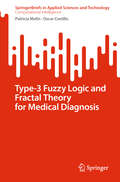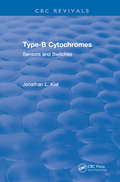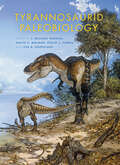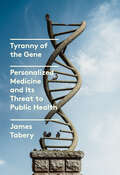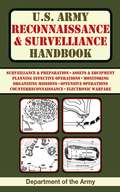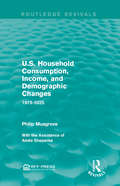- Table View
- List View
Type-3 Fuzzy Logic and Fractal Theory for Medical Diagnosis (SpringerBriefs in Applied Sciences and Technology)
by Oscar Castillo Patricia MelinThis book is intended to be a reference for scientists and engineers interested in applying type-3 fuzzy logic and fractal theory techniques in medical diagnosis. In this book, a new model based on type-3 fuzzy logic and fractal theory for applications in medical diagnosis is presented. The main idea is that a higher type and order of fuzzy logic can help in solving various diagnosis problems and find better results. In addition, fractal theory is also employed for enhancing medical diagnosis. In this regard, several hybrid intelligent methods are offered. In this book, the authors test the proposed methods using several medical diagnosis problems, like diagnosis of problems in the brain, hearth, lungs, and others. The authors can notice that when type-3 fuzzy systems are implemented to model the behavior of systems, the results in diagnosis are enhanced, because the management of uncertainty is better. For this reason, the authors consider in this book the proposed methods using type-3 fuzzy systems and fractal theory to improve the diagnosis in complex medical problems.
Type-B Cytochromes: Sensors and Switches
by J.L. KielThis book describes cellular level sensors that act as switches, turning on gene expression and other metabolic processes necessary for cell survival and differentiation. These responses can also initiate programmed cell death or activate latent human immunodeficiency virus or animal leukemia viruses. These redox sensors are nonspecific in sensitivity but specific in response. Unlike ligand/antiligand-type specific sensors, they respond to ionizing and ultraviolet radiations, pH gradients, heat, light, electric and magnetic fields, redox chemicals, mechanical stress, and other nonspecific stressors. The sensors are type-b cytochromes, including NADPH oxidases, NO synthases, and nitrogen oxide reductases. The intense radiation of early pre-biotic earth may have been the evolutionary driving force for the development of their common ancestor.
Typicality Reasoning in Probability, Physics, and Metaphysics (New Directions in the Philosophy of Science)
by Dustin LazaroviciThis book provides a comprehensive investigation into the concept of typicality and its significance for physics and the philosophy of science. It identifies typicality as a fundamental way of reasoning, central to how natural laws explain and are tested against phenomena. The book discusses various applications of typicality to foundational questions in physics and beyond.These include:a unified interpretation of objective probabilities in classical mechanics and quantum mechanicsa detailed discussion of Boltzmann's statistical mechanics, entropy, and the second law of thermodynamicsa novel account of the asymmetry of causation and the arrow of time Finally, the book turns to the question: "What are laws of nature"? It argues that typicality extends to a powerful way of reasoning in metaphysics that can and should inform our commitments about the fundamental ontology of the world. On this basis, it develops an argument against the Humean best system account, according to which laws of nature are merely an efficient summary of contingent regularities.
Tyrannical Minds: Narcissism, Personality, And Dictatorship
by Dean A. HaycockAn incisive examination into the pairing of psychology and situation that creates despotic leaders from the author of Murderous Minds. Not everyone can become a tyrant. It requires a particular confluence of events to gain absolute control over entire nations. First, you must be born with the potential to develop brutal personality traits. Often, these are combined in “The Dark Triad” of malignant narcissism, Machiavellianism and psychopathy, as well as elements of paranoia, and an extraordinary ambition to achieve control over others. Second, your predisposition to antisocial behavior must be developed and strengthened during childhood. You might suffer physical and/or psychological abuse, or grow up in trying times. Finally, you must come of age when the political system of your country is unstable. Together, these events establish a basis for a rise to power, one that Joseph Stalin, Adolf Hitler, Mao Zedong, Saddam Hussein, and Muammar Qaddafi all used to gain life-and-death control over their countrymen and women. It is how Osama bin Laden and the leaders of the Islamic State hoped to gain such power. Though these men lived in different times and places, and came from vastly different backgrounds, many of them felt respect for each other. They often seemed to recognize their shared, “dark” personality traits and viewed them as strengths. Only in rare cases did they show signs of mental disorders. “Getting inside the heads” of foreign leaders and terrorists is one way governments try to understand, predict, and influence their actions. Psychological profiles can help us understand the urges of tyrants to dominate, subjugate, torture and slaughter. Tyrannical Minds reveals how recognizing their psychological traits can provide insight into the motivations and actions of dangerous leaders, potentially allow to us predict their behavior?and even how to stop them. As strongmen and authoritarian leaders around the world increase in number, understanding the most extreme examples of tyrannical behavior should serve as a warning to anyone indifferent to the threats posed by political extremism.
Tyrannosaurid Paleobiology (Life Of The Past Ser.)
by Philip J. Currie Ralph E. Molnar J. Michael Parrish Eva B. KoppelhusThe opening of an exhibit focused on "Jane," a beautifully preserved tyrannosaur collected by the Burpee Museum of Natural History, was the occasion for an international symposium on tyrannosaur paleobiology. This volume, drawn from the symposium, includes studies of the tyrannosaurids Chingkankousaurus fragilis and "Sir William" and the generic status of Nanotyrannus; theropod teeth, pedal proportions, brain size, and craniocervical function; soft tissue reconstruction, including that of "Jane"; paleopathology and tyrannosaurid claws; dating the "Jane" site; and tyrannosaur feeding and hunting strategies. Tyrannosaurid Paleobiology highlights the far ranging and vital state of current tyrannosaurid dinosaur research and discovery.
Tyranny from Ancient Greece to Renaissance France
by Orest RanumThis Palgrave Pivot examines how prominent thinkers throughout history, from ancient Greece to sixteenth-century France, have perceived tyrants and tyranny. Ancient philosophers such as Plato and Aristotle were the first to build a vocabulary for tyrants and the forms of government they corrupted. Thirteenth century analyses of tyranny by Thomas Aquinas and John of Salisbury, revived from Antiquity, were recast as short observations about what tyrants do. They claimed that tyrants govern for their own advantage, not for the people. Tyrants could be usurpers, increase taxes, and live in luxury. The list of tyrannical actions grew over time, especially in periods of turmoil and civil war, often raising the question: When can a tyrant be legitimately deposed or killed? In offering a brief biography of these political philosophers, including Machiavelli, Erasmus, More, Bodin, and others, along with their views on tyrannical behavior, Orest Ranum reveals how the concept of tyranny has been shaped over time, and how it still persists in political thought to this day.
Tyranny of the Gene: Personalized Medicine and Its Threat to Public Health
by James TaberyA revelatory account of how power, politics, and greed have placed the unfulfilled promise of personalized medicine at the center of American medicineThe United States is embarking on a medical revolution. Supporters of personalized, or precision, medicine—the tailoring of health care to our genomes—have promised to usher in a new era of miracle cures. Advocates of this gene-guided health-care practice foresee a future where skyrocketing costs can be curbed by customization and unjust disparities are vanquished by biomedical breakthroughs. Progress, however, has come slowly, and with a price too high for the average citizen.In Tyranny of the Gene, James Tabery exposes the origin story of personalized medicine—essentially a marketing idea dreamed up by pharmaceutical executives—and traces its path from the Human Genome Project to the present, revealing how politicians, influential federal scientists, biotech companies, and drug giants all rallied behind the genetic hype. The result is a medical revolution that privileges the few at the expense of health care that benefits us all.Now American health care, driven by the commercialization of biomedical research, is shifting focus away from the study of the social and environmental determinants of health, such as access to fresh and nutritious food, exposure to toxic chemicals, and stress caused by financial insecurity. Instead, it is increasingly investing in &“miracle pills&” for leukemia that would bankrupt most users, genetic studies of minoritized populations that ignore structural racism and walk dangerously close to eugenic conclusions, and oncology centers that advertise the perfect gene-drug match, igniting a patient&’s hope, and often dashing it later.Tyranny of the Gene sounds a warning cry about the current trajectory of health care and charts a path to a more equitable alternative.
Tyranny, Inc.: How Private Power Crushed American Liberty--and What to Do About It
by Sohrab AhmariThe inside story of how our political class enabled an era of unaccountable corporate might that left ordinary Americans isolated and powerless—and how we can fight back—from the acclaimed author of The Unbroken Thread&“In Tyranny, Inc., Sohrab Ahmari, one of the leading thinkers of our time, alerts us to one of the greatest threats to freedom.&”—Michael Lind, author of The New Class War and Hell to PayOver the past two generations, U.S. leaders deregulated big business on the faith that it would yield a better economy and a freer society. But the opposite happened. Americans lost stable, well-paying jobs, Wall Street dominated industry to the detriment of the middle class and local communities, and corporations began to subject us to total surveillance, even dictating what we are, and aren&’t, allowed to think. The corporate titans and mega-donors who aligned themselves with this vision knew exactly what they were getting: perfect conditions for what Sohrab Ahmari calls &“private tyranny&”.Drawing on original reporting and a growing chorus of experts who are sounding the alarm, Ahmari chronicles how private tyranny has eroded America&’s productive economy and the liberties we take for granted—from employment agreements that gag whistleblowers, to Big Finance&’s takeover of local fire departments, to the rigging of corporate bankruptcy to deny justice to workers and consumers—illuminating how these and other developments have left millions feeling that our livelihoods are insecure. And he shows how ordinary Americans can fight back, by restoring the economic democracy that empowered and uplifted millions of working-class people in the twentieth century.Provocative, original, and cutting across partisan lines, Tyranny, Inc. is a revelatory read on the most important political story of our time.
U Can: Chemistry I For Dummies
by John T. Moore Peter J. Mikulecky Chris HrenNow you can score higher in chemistry Every high school requires a course in chemistry for graduation, and many universities require the course for majors in medicine, engineering, biology, and various other sciences. U Can: Chemistry I For Dummies offers all the how-to content you need to enhance your classroom learning, simplify complicated topics, and deepen your understanding of often-intimidating course material. Plus, you'll find easy-to-follow examples and hundreds of practice problems--as well as access to 1,001 additional Chemistry I practice problems online! As more and more students enroll in chemistry courses,, the need for a trusted and accessible resource to aid in study has never been greater. That's where U Can: Chemistry I For Dummies comes in! If you're struggling in the classroom, this hands-on, friendly guide makes it easy to conquer chemistry. Simplifies basic chemistry principles Clearly explains the concepts of matter and energy, atoms and molecules, and acids and bases Helps you tackle problems you may face in your Chemistry I course Combines 'how-to' with 'try it' to form one perfect resource for chemistry students If you're confused by chemistry and want to increase your chances of scoring your very best at exam time, U Can: Chemistry I For Dummies shows you that you can!
U Can: Physics I For Dummies
by Steven Holzner Daniel Funch WohnsTake the fear out of Physics I If the thought of studying physics makes you sweat, you can finally have something to rest easy about! U Can: Physics I For Dummies takes the intimidation out of this tough subject, offering approachable lessons, examples, and practice opportunities-as well as access to additional practice problems online. With this one-stop resource, you'll find friendly and accessible instruction on everything you'll encounter in your Physics I course and will gain the practice and confidence you need to score high at exam time. Inside this comprehensive study resource, how-to lessons are thoughtfully blended with practical examples and problems to help you put your knowledge to practice and gauge your comprehension of the physics topics presented. Lessons and practice problems are fully integrated and track to a typical Physics I course, giving you one mega-resource that combines the 'how-to' you need with the 'do it' practice you want to keep the physics anxiety at bay. Get up to speed on the basic concepts of physics Grasp physics formulas in a clear and concise manner Explore the newest discoveries in the field Access additional practice problems online If you're looking for an all-inclusive product to help with your Physics I coursework, U Can: Physics I For Dummies has it all-and then some!
U.S. Agriculture in a Global Setting: An Agenda for the Future (Routledge Revivals)
by M. Ann TutwilerThe theme of the 1987/88 annual review of the National Center for Food and Agricultural Policy (NCFAP) specifically considers that while the world in which agricultural policy operates has changed dramatically over the decades, agricultural policies have not taken account of those changes in any fundamental way. Originally published in 1988, this volume examines the setting in which U.S. agriculture finds itself and suggests an agenda for future policy. This title is a valuable resource for policy makers and students interested in environmental studies, agricultural practices, and national policy.
U.S. Army Guerrilla Warfare Handbook
by ArmyThey can be swift, silent, and deadly. That's why armed guerrillas are feared by even the largest, best-equipped fighting forces. No tank, rocket-propelled grenade, or infantry battalion can match the guerrilla team's ability to exact brutality with precision, instill fear in enemy hearts, and viciously deflate morale. From the snows of Korea to the jungles of Southeast Asia to the mountains of Afghanistan, the U.S. Army has employed guerrilla tactics to deadly effect. Those tactics and techniques, being used today by U.S. soldiers, are laid out in the U.S. Army Guerrilla Warfare Handbook. Employing small, heavily-armed, and well-oiled fire teams, guerrilla warfare has played an invaluable role in the success of nearly every U.S. campaign for decades. Here, its methods are detailed: raids and ambushes, demolition, counterintelligence, mining and sniping, psychological warfare, communications, and much more. This is an inside look at the guerrilla strategies and weapons that have come to be feared by enemies and respected by allies. Not another outside perspective or commentary on unconventional warfare, this is the original--of use to soldiers in the field and to anyone with an interest in military tactics.
U.S. Army Guide to Military Mountaineering (US Army Survival)
by ArmyMountains exist in almost every country in the world and almost every war has included some type of mountain operations. This pattern will not change, and soldiers will continue to fight in mountainous terrain in future conflicts. Although mountain operations have not changed, several advancements in equipment and transportation have increased the soldiers' capabilities. The helicopter now allows access to terrain that was once unreachable or could be reached only by slow methodical climbing. Inclement weather, however, may place various restrictions on the capabilities of air assets available to a commander. The unit must then possess the necessary mountaineering skills to overcome adverse terrain to reach an objective.The U.S. Army Guide to Military Mountaineering details techniques soldiers and leaders must know to cope with mountainous terrain. These techniques are the foundation upon which the mountaineer must build. They must be applied to the various situations encountered to include river crossings, glaciers, snow-covered mountains, ice climbing, rock climbing, and urban vertical environments. The degree to which this training is applied must be varied to conform to known enemy doctrine, tactics, and actions. This guide also discusses basic and advanced techniques to include acclimatization, illness and injury, equipment, anchors, evacuation, movement on glaciers, and training.
U.S. Army Improvised Munitions Handbook: Explosives & Propellants, Mines & Grenades, Mortars & Rockets, Small Arms Weapons & Ammunition Fuses, Detonators, & Delay Mechanisms (US Army Survival)
by ArmyYou don’t need to be a trained soldier to fully appreciate this edition of the U.S. Army Improvised Munitions Handbook (TM 31-210). Originally created for soldiers in guerilla warfare situations, this handbook demonstrates the techniques for constructing weapons that are highly effective in the most harrowing of circumstances. Straightforward and incredibly user-friendly, it provides insightful information and step-by-step instructions on how to assemble weapons and explosives from common and readily available materials. Over 600 illustrations complement elaborate explanations of how to improvise any number of munitions from easily accessible resources. Whether you’re a highly trained solider or simply a civilian looking to be prepared, the U.S. Army Improvised Munitions Handbook is an invaluable addition to your library.
U.S. Army Intelligence and Interrogation Handbook: The Official Guide On Prisoner Interrogation (US Army Survival)
by ArmyThe U.S. Army Intelligence and Interrogation Handbook provides doctrinal guidance, techniques, and procedures governing the use of interrogators as human intelligence collection agents in support of a commander's intelligence needs. It outlines the interrogator's role within the greater intelligence effort as well as the unit's day-to-day operations, and includes details on how interrogators accomplish their assigned missions. This handbook is intended for use by interrogators as well as commanders, staff officers, and military intelligence personnel charged with conducting interrogations, and applies to operations at all levels of conflict intensity, including conditions involving the use of electronic warfare or nuclear, biological, or chemical weapons.The U.S. Army Intelligence and Interrogation Handbook builds upon existing doctrine and moves interrogation into the twenty-first century within the constraints of the Uniform Code of Military Justice and the Geneva Conventions. Principles, guidelines, and topics covered include:The definition of interrogationInterrogator capabilities and limitationsWarfighting doctrineThe intelligence cycle, and its disciplines and operationsAmphibious and airborne operationsThe interrogation processExploiting captured enemy documentsA tactical questioning guideAnd many more tactics and techniques used by the U.S. Army!
U.S. Army Ranger Handbook (Us Army Survival Ser.)
by ArmyThis handbook offers the techniques and tactics that make Army Rangers the best soldiers in the world. These highly-trained, easily-deployable, and widely-skilled infantrymen specialize in airborne assault, raids, recovery of personnel and equipment, and airfield seizure, among other difficult and dangerous missions. Drawing from over two centuries of bloody lessons learned in special operations combat, this guide gives modern soldiers the best advice possible. In straightforward language and a no-frills style, it covers deception, stealth, communications, escape and evasion, ambush operations, perimeter defense, counterintelligence, and much more. Handy and concise, this manual was designed so Rangers could easily carry it into the field. Now it is the ultimate resource for anyone who wants to know how Rangers think and work.
U.S. Army Reconnaissance and Surveillance Handbook (US Army Survival)
by ArmyThroughout history, military leaders have recognized the importance of reconnaissance and surveillance. Gaining and maintaining contact with the enemy is essential to win the battle, and U.S. military history contains many examples where our knowledge of the enemy, or lack of knowledge, directly led to victory or defeat. The role of reconnaissance and surveillance has not diminished on the modern battlefield; if anything, it has become even more important. Battles at the combat training centers prove that a good reconnaissance and surveillance effort is critical to successful attacks. On the other hand, a poor reconnaissance and surveillance effort almost guarantees defeat for the commander. The message is clear: success on the battlefield begins with reconnaissance and surveillance.Direct from the United States Army, U.S. Army Reconnaissance and Surveillance Handbook provides tactics, techniques, and procedures for reconnaissance and surveillance planning, mission management, and reporting. It also covers the development of intelligence to support counter-reconnaissance operations, employment considerations for reconnaissance, and surveillance assets, and defines the roles of various personnel in planning operations. Intended for maneuver commanders and their staffs; intelligence staffs and collection managers; and other personnel involved in planning and reconnaissance and counter-reconnaissance operations, and now available to everyone, U.S. Army Reconnaissance and Surveillance Handbook provides an insider's look into the world of Army intelligence.
U.S. Army Weapons Systems 2009
by ArmyIn addition, it covers cutting-edge tech that will soon be employed by our soldiers: missiles, small arms, biological detection systems, rockets, reconnaissance systems, radios, planes, bows and arrows (believe it or not)...you name it, this book has it. Also included is a thorough discussion of Future Combat Systems (FCS), the system of systems that, when fully operational, will provide the Army and joint forces with unprecedented capability to see the enemy, engage him on our terms, and defeat him on the twenty-first century battlefield. Full-color photographs illustrate each weapon, making this the most comprehensive and up-to-date resource of its kind.
U.S. Astronomy and Astrophysics: MANAGING AN INTEGRATED PROGRAM
by National Research CouncilThe National Academies Press (NAP)--publisher for the National Academies--publishes more than 200 books a year offering the most authoritative views, definitive information, and groundbreaking recommendations on a wide range of topics in science, engineering, and health. Our books are unique in that they are authored by the nation's leading experts in every scientific field.
U.S. Conventional Prompt Global Strike: ISSUES FOR 2008 AND BEYOND
by National Research Council of the National AcademiesConventional prompt global strike (CPGS) is a military option under consideration by the U.S. Department of Defense. This book, the final report from the National Research Council’s Committee on Conventional Prompt Global Strike Capability, analyzes proposed CPGS systems and evaluates the potential role CPGS could play in U.S. defense. U.S. Conventional Prompt Global Strike provides near-, mid-, and long-term recommendations for possible CPGS development, addressing the following questions: Does the United States need CPGS capabilities?What are the alternative CPGS systems, and how effective are they likely to be if proposed capabilities are achieved?What would be the implications of alternative CPGS systems for stability, doctrine, decision making, and operations? What nuclear ambiguity concerns arise from CPGS, and how might they be mitigated? What arms control issues arise with CPGS systems, and how might they be resolved? Should the United States proceed with research, development, testing, and evaluation (RDT&E) of the Conventional Trident Modification (CTM) program5 and, ultimately, with CTM production and deployment? Should the United States proceed with the development and testing of alternative CPGS systems beyond CTM?
U.S. Counterterrorism: From Nixon to Trump – Key Challenges, Issues, and Responses
by Michael B. Kraft Edward Marks"Writing with years of experience in government, Ambassador Edward Marks and Michael Kraft have produced a splendid history of America’s long campaign against terrorism. The book analyzes the recent changes in technology and tactics that have profoundly altered today’s terrorist challenge…to understand where we are and how we got there, start here."—Brian Michael Jenkins, The Rand Corporation "…This book provides important perspective on where the United States has been in this fight and how that fight must evolve in the new administration. It is must reading for the Trump Administration and anyone else seriously concerned about the next steps in this long struggle." —Brig. Gen. Francis X Taylor, USAF (Rtd.), Former U.S. Coordinator for Counterterrorism and DHS Under Secretary for Intelligence and Analysis "…an indispensable guide to U.S. counterterrorism efforts and policies spanning five decades and nine presidencies … (The book) fills a significant gap in the literature by providing an invaluable historical context to this unending struggle." —Professor Bruce Hoffman, Director, Security Studies, Georgetown University "A clear and comprehensive survey of American policy toward terrorism over the past half century … it provides essential background for analysis of future policy." —Martha Crenshaw, Center for International Security and Cooperation, Stanford University U.S. Counterterrorism: From Nixon to Trump - Key Challenges, Issues, and Responses examines the "war on modern terrorism," from the Nixon administration to the early stages of the Trump administration. The book describes the evolution of U.S. counterterrorism responses to the changing terrorist threats, from primarily secular groups, to those with broad-reaching fundamentalist religious goals such as ISIS. The authors highlight the accelerating rate of changes in the terrorism situation from modern technology; the internet, "lone wolf" terrorists, cyber threats, and armed drones. The book describes the Bush Administration’s dealing with terrorism as an existential threat and a Global War on Terrorism following 9/11. It then discusses how the Obama administration both continued and modified previous policies. The book provides an extensive list of key documents for those interested in the original texts and a discussion of legal issues. U.S. Counterterrorism provides insights and a useful backdrop for future decisions by the new administration and Congress.
U.S. Energy Policies: An Agenda for Research (Routledge Revivals)
by Resources For The Future LtdU.S. Energy Policies, first published in 1968, aims to assemble and describe within an overall framework the energy policy questions that RRF believed would profit from study and analysis. This study covers the past performance and trends in the energy industries, the nature of existing industries and of the government policies bearing on them, and the effects of those policies. This title also takes note of the prospective influence of economic and technological developments and evaluates the probable effects of selected alternatives to existing policies. This book will be of interest to students of environmental studies.
U.S. Food: Making The Most Of A Global Resource
by David W. McclintockThis volume focuses on the basic dilemma inherent in the formulation and implementation of agricultural policies in the United States: many of the best short-term options are the worst ones for the long run, and vice versa. The study begins with an overview of the world food problem, including both the negative and positive issues that give rise to
U.S. Government Counterterrorism: A Guide to Who Does What
by Michael Kraft Edward MarksU.S. Government Counterterrorism: A Guide to Who Does What is the first readily available, unclassified guide to the many U.S. government agencies, bureau offices, and programs involved in all aspects of countering terrorism domestically and overseas. The authors, veterans of the U.S. government‘s counterterrorism efforts, present a rare insider‘s
U.S. Household Consumption, Income, and Demographic Changes: 1975-2025 (Routledge Revivals)
by Philip MusgroveThe impacts of the two variables of population and income growth on resources and the environment are transmitted through their effects on the demands for goods and services. To enrich our understanding of the impacts of population and income on consumer demand, Philip Musgrove, with the assistance of Adele Shapanka, undertook the research in this volume, which was first published in 1982. This book will be of interest to students of economics and environmental studies.
